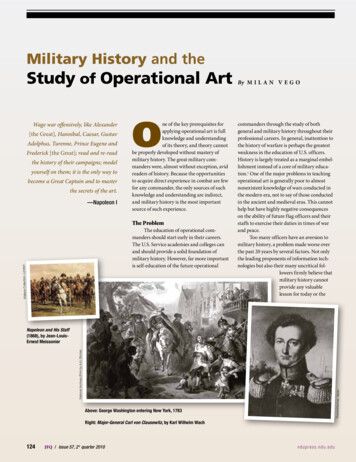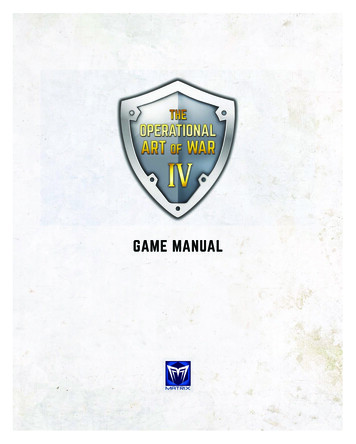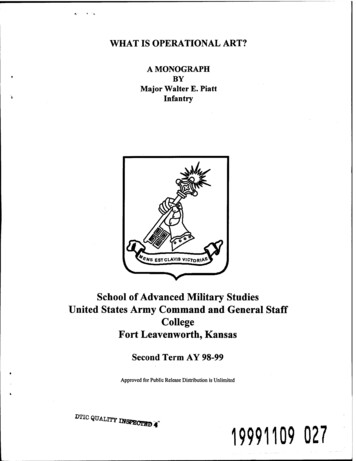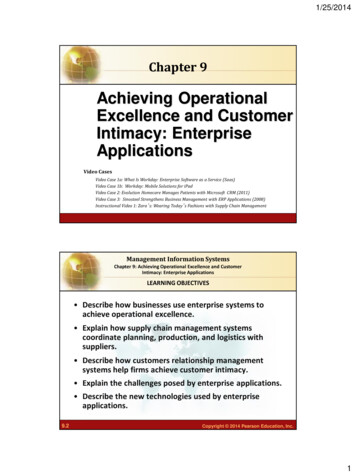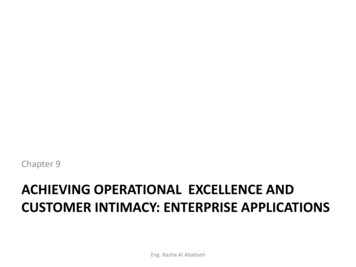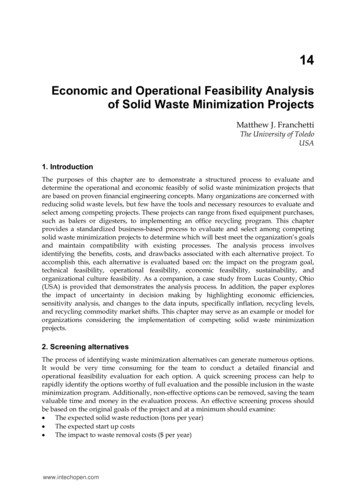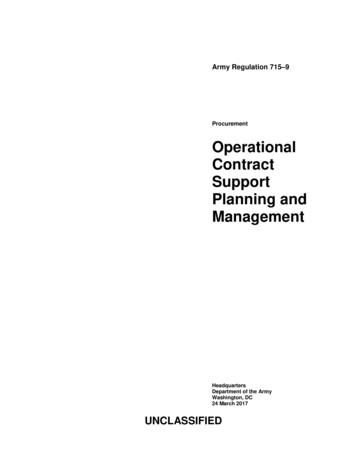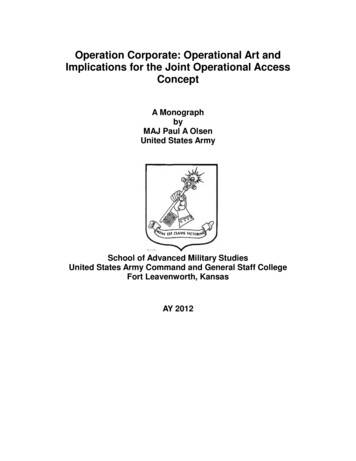
Transcription
Operation Corporate: Operational Art andImplications for the Joint Operational AccessConceptA MonographbyMAJ Paul A OlsenUnited States ArmySchool of Advanced Military StudiesUnited States Army Command and General Staff CollegeFort Leavenworth, KansasAY 2012
Form ApprovedOMB No. 074-0188REPORT DOCUMENTATION PAGEPublic reporting burden for this collection of information is estimated to average 1 hour per response, including the time for reviewing instructions, searching existing data sources, gathering and maintainingthe data needed, and completing and reviewing this collection of information. Send comments regarding this burden estimate or any other aspect of this collection of information, including suggestions forreducing this burden to Washington Headquarters Services, Directorate for Information Operations and Reports, 1215 Jefferson Davis Highway, Suite 1204, Arlington, VA 22202-4302, and to the Office ofManagement and Budget, Paperwork Reduction Project (0704-0188), Washington, DC 205031. AGENCY USE ONLY (Leave2. REPORT DATE3. REPORT TYPE AND DATES COVEREDblank)10-05-2012SAMS Monograph 28-06-2011 tp 10-05-20124. TITLE AND SUBTITLE5. FUNDING NUMBERSOperation Corporate: Operational Art and the Implications for the Joint Operational AccessConcept6. AUTHOR(S)Major Paul A. Olsen7. PERFORMING ORGANIZATION NAME(S) AND ADDRESS(ES)8. PERFORMING ORGANIZATIONREPORT NUMBERSchool of Advanced Military Studies201 Reynolds AvenueFort Leavenworth, KS 66027-23019. SPONSORING / MONITORING AGENCY NAME(S) AND ADDRESS(ES)U.S. Army Command and General Staff CollegeATTN: ATZL-SWD-GDFort Leavenworth, KS 66027-230110. SPONSORING / MONITORINGAGENCY REPORT NUMBER11. SUPPLEMENTARY NOTES12a. DISTRIBUTION / AVAILABILITY STATEMENT12b. DISTRIBUTION CODEApproved for Public Release; Distribution is Unlimited13. ABSTRACT (Maximum 200 Words)This paper explores the development of an operational approach to secure the Falkland Islands following the Argentineinvasion on 30 March 1982. The Falklands Islands campaign is a case study of operational art and the development of an operationalapproach by the military leaders of the United Kingdom. Operational movement, force employment, and the influence of national policydecisions all contributed to the modification and adaptation of their campaign plan. This campaign, characterized by joint maritime andland operations in a distributed area of operations, provides a way ahead for the application of operational art in emerging contingenciesbased on an understanding of the relationship between theory, joint doctrine, and actual execution of tactical actions. Joint OperationalAccess Concept precepts and their application during this campaign provide relevance to ensure access during forcible entry operations.JOAC principles focus on the requirement to develop an operational approach, along multiple distributed lines of operation, employingprecision strikes at operational distance, and denying or defeating the enemy’s anti-access or area denial capabilities. Using a historicalcase study serves as a proof of concept to provide a compelling narrative and cautionary tale regarding the implementation of thisoperational access concept.14. SUBJECT TERMS15. NUMBER OF PAGESOperation Corporate, operational art, operational approach, Falkland Islands, US andBritish joint military doctrine, command and control, Joint Operational Access Concept16. PRICE CODE17. SECURITY CLASSIFICATIONOF REPORT18. SECURITY CLASSIFICATIONOF THIS PAGE(UNCLASSFIED)(UNCLASSIFIED)NSN 7540-01-280-550019. SECURITY CLASSIFICATIONOF ABSTRACT(UNCLASSIFED)5020. LIMITATION OF ABSTRACT(UNCLASSIFIED)Standard Form 298 (Rev. 2-89)Prescribed by ANSI Std. Z39-18298-102
SCHOOL OF ADVANCED MILITARY STUDIESMONOGRAPH APPROVALMajor Paul Alan OlsenTitle of Monograph: Operation Corporate: Operational Art and Implications for theJoint Operational Access ConceptApproved by:Nathan W. Toronto, Ph.D.Monograph DirectorThomas C. Graves, COL, INDirector,School of AdvancedMilitary StudiesRobert F. Baumann, Ph.D.Director,Graduate DegreeProgramsDisclaimer: Opinions, conclusions, and recommendations expressed or implied within are solelythose of the author, and do not represent the views of the US Army School of Advanced MilitaryStudies, the US Army Command and General Staff College, the United States Army, theDepartment of Defense, or any other US government agency. Cleared for public release:distribution unlimited.i
AbstractOperation Corporate: Operational Art and Implications for the Joint Operational Access Conceptby MAJ Paul A Olsen, United States Army, 44 pages.This paper explores the development of an operational approach to secure the FalklandIslands following the Argentine invasion on 30 March 1982. The Falklands Islands campaign is acase study of operational art and the development of an operational approach by the militaryleaders of the United Kingdom. Operational movement, force employment, and the influence ofnational policy decisions all contributed to the modification and adaptation of their campaignplan. This campaign, characterized by joint maritime and land operations in a distributed area ofoperations, provides a way ahead for the application of operational art in emerging contingenciesbased on an understanding of the relationship between theory, joint doctrine, and actual executionof tactical actions. Joint Operational Access Concept precepts and their application during thiscampaign provide relevance to ensure access during forcible entry operations. JOAC principlesfocus on the requirement to develop an operational approach, along multiple distributed lines ofoperation, employing precision strikes at operational distance, and denying or defeating theenemy’s anti-access or area denial capabilities. Using a historical case study serves as a proof ofconcept to provide a compelling narrative and cautionary tale regarding the implementation ofthis operational access concept.ii
Table of ContentsIntroduction . 1Theory and Doctrine . 2The Strategic Context . 5Geo-Political Background . 5Political Background . 7Military Background . 10An Overview of Operation Corporate . 13Deploying and Staging the Task Force. 13Establishment of the Maritime Exclusion Zone . 18Amphibious Operations . 20Operational Approach Development and Adaptation . 24Lessons Learned from the Falklands Campaign. 33Implications for Joint Operational Access. 37Conclusions . 38BIBLIOGRAPHY . 42iii
IllustrationsFigure 1: The Falkland Islands. . 6Figure 2: Strategic and Operational Distance. . 9iv
IntroductionThe Falklands War of 1982 between Great Britain and Argentina offers a compellingperspective on the complex interrelationships of war: the lines between politics and militaryactions, the integration of air, land, and sea efforts, the centrality of logistics in the conduct of thecampaign, and the dominance of terrain and weather in operational concepts. The Falklandscampaign is a near perfect model of a campaign: geographically isolated, offering distinctadvantages and disadvantages to each adversary, fought with weapon systems remarkably similarfor both sides, set against an intense political background, and brought to a decisive victory forthe British in only seventy-five days. While it was not without its share of tragedies, thiscampaign is ultimately known for brilliantly executed, well-led, courageously fought battles bymen seeking to do their duty as they understood it.This monograph explores the broad body of literature about the Falkland Islandscampaign to answer the following question: How did the United Kingdom successfully achieveits campaign objectives in light of the evolving strategic and tactical events during the FalklandsWar? To answer the research question the paper will define the role of operational planning intheory and practice as well as the importance of relating the strategic end state to the operationalapproach. This monograph focuses on the role of doctrine, command and control structures, andthe development of a British operational approach during the Falkland Islands campaign.Closely related to the issue of military and political interrelationships is the matter ofintegrating tactics and operations with strategy to achieve political ends. In the Falkland Islandscampaign, the British operational commander considered the arrangement of tactical actions toachieve strategic objectives, although not without adaptation and miscues along the way.Command and control structures as well as confusion regarding command relationships amplifiedthe frictions resulting from limited resources, communications, and the environment itself.Comparing current methods of operational art and the British approach afford us an opportunity1
to test the relevance of a theory that formalized doctrine, education, and experience were notequally weighted during the development of the British campaign plan for the Falklands War.Finally, this monograph looks at the role of operational art as it pertains to the FalklandsIslands campaign and the United States military’s recently published Joint Operational AccessConcept (JOAC). In many respects, the Falklands Islands campaign illustrates many of theprecepts articulated in the JOAC to include the primacy of operational initiative, cross-domainsynergy, and basing options to retain flexibility during planning and operations.1 In short, to whatextent did commanders and planning staffs apply these tenets of operational warfare and how arethey relevant to the emerging American military concept of projecting and sustaining jointcombat power against an armed opposing force? This is especially relevant considering theproliferation of weapons and other technologies capable of denying access to or freedom of actionwithin an operational area.Theory and DoctrineA review of classical and contemporary military theory develops an appreciation ofoperational art during this period. Vego’s Operational Warfare at Sea: Theory and Practice andCorbett’s Some Principle of Maritime Strategy provide the intellectual underpinning of maritimeforce employment and combined operations. 2 Three variables mentioned in Biddle’s MilitaryPower influenced the development of the British operational approach: technology,preponderance, and force employment. 3 While technology and material preponderance favored1Department of Defense, “Joint Operational Access Concept,” (Washington DC: GovernmentPrinting Office, 2012), ii–iii.2Milan Vego, Operational Warfare at Sea: Theory and Practice (New York: Routledge, 2009),3–5; Julian Corbett, Some Principle of Maritime Strategy (Annapolis, MD: Naval Institute Press, 1988),91–106. Maritime force has to be regarded in a joint context in which naval assets enable the actionsexecuted ashore by land forces. Maritime power projection facilitates the intervention at a time and place ofpolitical choice and an opportunity to exploit joint assets.3Stephen Biddle, Military Power: Explaining Victory and Defeat in Modern Battle (Princeton, NJ:Princeton University Press, 2004), 48–51.2
the Argentinean forces, the British military’s method of force employment is particularly salientin this study. The impact of force employment during the Falklands Islands campaigndemonstrates the importance of adaptation in operational planning based on an understanding ofthe interaction between strategy and tactics.The strategic context of the conflict provided by Hastings and Jenkins perspective of theBattle for the Falklands encompasses a broad range of tactical actions and strategic decisions thatprovide insight into the strategic and operational decision-making process. Watson and Dunnprovide an American perspective on lessons learned from the Falkland Islands War while theUnited Kingdom’s official report on the Falklands summarizes salient strategic and operationallessons learned during the course of the war. Freedman’s two-volume Official History of theFalklands Campaign discusses strategic-political maneuvering as well as the tension between theoperational commanders and tactical commanders during the Falklands War. In The FalklandsConflict Twenty Years On: Lessons for the Future, the authors argue the experience during theFalklands conflict is not isolated to that period and has implications for contingency operationscharacterized by extreme operational reach, limited means, and the necessity of a clearly definedstrategic end state.Current US joint doctrine defines an operational approach as the “broad actions the forcemust take to transform current conditions into those desired at end state” while operational art is“the use of creative thinking by commanders and staffs to design strategies, campaigns, and majoroperations and organize and employ military forces.” 4 An understanding of existing doctrineguiding expeditionary warfare and the professional military education system serves to illuminatethe methods available to the British during this campaign. This is critical to the question since4US Department of Defense, Joint Publication 3-0, Joint Operations (Washington DC:Government Printing Office, 2011), II-7.3
formal doctrinal manuals—as understood by the US military—did not exist in the British armedforces until after the Falkland Islands campaign.Papers from the Joint Services Command and Staff Course (JSCSC) regardingprofessional military education and JSCSC monographs focused on operational art during theFalkland Islands War highlight the influence of doctrine, formal education, and experience. Thesemonographs and reports focus on the operational level of war with particular attention to thecommand relationships, command and control structures employed during the campaign, anddiscussions on the state of British operational art in the early 1980s. The analysis of the campaignand lessons learned provide a detailed understanding of the challenges faced by the Britishoperational commanders during this campaign. The importance of the commander duringoperational planning and adaptation during “out of area” operations is an issue that the Britishaddressed after the campaign through development of joint doctrine and professional educationprograms. This perspective provides additional insight into the intellectual underpinning,cognitive development, and espoused military theory during this period and the years followingthe campaign.An overview of the JOAC precepts and their application during Operation Corporateprovides relevance to the newly published concept to ensure access during forcible entryoperations. The JOAC provides principles that focus on the requirement to develop a unifiedoperational approach, operating along multiple distributed lines of operation, employing precisionstrikes at operational distance, and denying or defeating the enemy’s anti-access or area denialcapabilities through a combination of deception, stealth, and ambiguity. 5 The monograph willillustrate the application or omission of these principles during the operational overview later inthe paper. This serves as a proof of concept using a historical case study to provide a compellingnarrative and cautionary tale regarding the implementation of this operational access concept.5Department of Defense, “Joint Operational Access Concept,” 17.4
The Strategic ContextGeo-Political BackgroundAt first glance, it appears that the Falkland Islands are of minimal strategic importance toeither Great Britain or Argentina. A distance of over 7,500 miles separates Britain from theFalklands while Argentina is 300 miles distant to the west. Situated close to the Antarctic Circlebetween latitudes 51 and 52 degrees, the Falklands endured a harsh and inhospitable climate thatkept them uninhabited until the late 17th century. The crew of the British Royal Navy ship Desireoriginally sighted the islands in 1592, and not until 1690 did the British crew of the Welfare landon the islands themselves. 6 Argentina did not exist at this time, and the islands remainedessentially unclaimed.The two main islands, East and West Falklands, are separated by the Strait of San Carlosor Falkland Sound and generally follow a northeast to southwest orientation. As illustrated inFigure 1, irregular coastlines characterize both East and West Falklands; this feature in turn led tothe formation of many good landing sites and potential harbors. The land surface on both islandsis generally hilly and barren. The islands themselves have little to offer. The terrain is treeless andwindswept, and only the grasslands ashore and the fishing of the seas adjacent offer anylivelihood to the inhabitants. Early settlers introduced cattle, later replaced by sheep, to feed offthe grass. By 1972, the 4,700 square miles of the Falkland Islands supported a population of onlyabout 2000, over half of them in the main settlement of Stanley.6Peter Calvert, The Falklands Crisis (New York: St. Martin’s Press, 1982), 5.5
Figure 1: The Falkland Islands. 7Shortly after the independence of Buenos Aires in 1816, the Argentinean governmentestablished a penal colony on the islands. However, the strategic concerns of Britain required theestablishment of a way station on the important route around the Cape of Good Hope into thePacific Ocean. This led Britain to reassert its rights of sovereignty based on a consistent history ofclaim to the islands. The frigate Cleo deployed to the Falkland Islands in 1833 with orders toevict the Argentinean administrators and raise the Union Jack over the territory. This missionsucceeded and the British claim and sovereignty remained uninterrupted until 1 April 1982. 8The strategic importance of the Falkland Islands had not increased over the years astechnology advanced and wind driven ships gave way to coal and steam powered vessels. Theislands remained a convenient location to refuel and refit, particularly for those ships that had7Map by Mark Lacey, The Origins of the Falklands War, vol. I of The Official History of theFalklands Campaign, (New York: Taylor & Francis, 2005), xiii.8Calvert, The Falklands Crisis, 5.6
recently completed the arduous passage around the Cape Horn from the Pacific Ocean, but wascertainly not critical to the security of the British Empire.The Falkland Islands were of even less st
Oct 05, 2012 · invasion on 30 March 1982. The Falklands Islands campaign is a case study of operational art and the development of an operational approach by the military leaders of the United Kingdom. Operational movement, force employment, and the influence of national policy decisions all contributed to the modification and adaptation of their campaign plan.Author: Paul A Olsen
